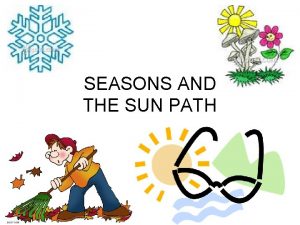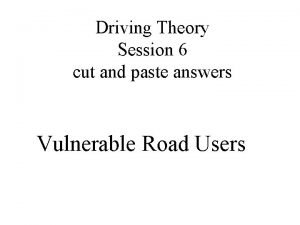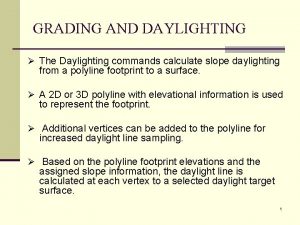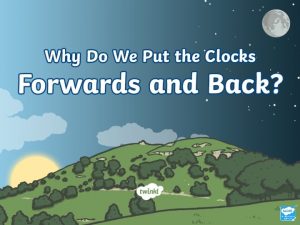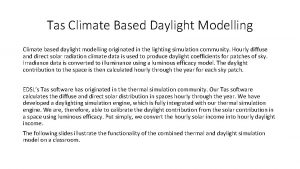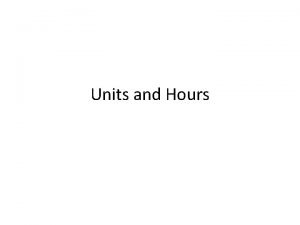Hours of Daylight During summer in Australia there











- Slides: 11


Hours of Daylight During summer in Australia there are more hours of daylight. The days stay lighter for longer. In the winter, there are less hours of daylight. The days become darker earlier in the evening.

The Shortest and Longest Days In Australia, the day that has the most hours of daylight in the year is usually the 22 nd December. This is called the summer solstice. When this happens the Suns track across the sky is at its highest point. The day with the fewest hours of daylight in the year is usually on the 22 nd June. This is called the winter solstice.

Clocks Forward, Clocks Back Start of Daylight Saving • Daylight saving time begins at 2 am on the first Sunday in October • Clocks are put forward one hour End of Daylight Saving • Daylight saving ends at 2 am on the first Sunday of April • Clocks move back an hour in New South Wales, Victoria, South Australia, Tasmania and the Australian Capital Territory

Making the Most of the Daylight George Hudson was an entomologist from New Zealand. He was the first person to come up with the idea of daylight saving time in 1895. He wrote a paper that included a plan to change the clocks by two hours. This change was really to give him more time in the afternoon to collect insects.

Making the Most of the Daylight In 1914, a man called William Willet noticed that people in London were sleeping through most of the summer sun. So he suggested that the clocks should be moved forward by one hour. This idea would also give him the chance to play golf for longer in the afternoon. He also pointed out that less coal and candles would be used because people would have lighter evenings.

First World War In April 1916, Germany became one of the first counties to switch to Daylight Saving Time (DST). This saved fuel during the war. They would turn the clocks forward by an hour in the summer, then back again in the winter. In May 1916, Britain also switched to DST. Some areas of Canada were already following DST, as early as 1908.

Australia and Daylight Saving The daylight savingdaylight debate comes now and again, butitthere Australia followed savingup in in the. Australia First andevery Second World War. But are no plans to change it yet. became permanent in the late 1960 s. In Australia wethe often or say ‘Daylight Time’ instead of ‘Daylight Tasmania was firstwrite to introduce daylight. Savings saving time. Saving Time’. Queensland, the Northern Territory and Western Australia do not have daylight saving. It is thought that these areas have warm temperatures most of the year, so extra summer hours are not needed. Did You Know…? Antarctica uses daylight saving time. However, many countries do not. Most of Asia and Africa do not change their clocks and less than half the countries in the world take part in daylight saving time.

Good Things and Bad Things Good things about DST: Not so good things about DST: • Less traffic accidents, as people can see more clearly in the light • Darker mornings can mean it is less safe for children to walk to school • Saves energy, as not many lights are used so less electricity is being used • Farmers get up early, so are working in the dark for longer • Some feel it affects sleeping patterns and their health • Can make it difficult to figure out time zones • More people exercise outdoors

How to Remember A great way to remember when the clocks go forwards or back is with this little phrase: Spring forward, Fall back. So in the spring, clocks go forward an hour and in the autumn, they go back an hour. In Australia we don't actually say ’fall’ but it is the American term used for autumn.

 North pole sun path
North pole sun path We visited australia last summer
We visited australia last summer Summer time australia
Summer time australia Claudette morel age
Claudette morel age Remains poem annotated
Remains poem annotated At night you see a pedestrian wearing
At night you see a pedestrian wearing Climate based daylight modelling
Climate based daylight modelling Don't delay dawns disarming display. dusk demands daylight
Don't delay dawns disarming display. dusk demands daylight Daylight line grading
Daylight line grading Dead by daylight cex
Dead by daylight cex Daylight pickoff play
Daylight pickoff play Cesario come for so you shall be
Cesario come for so you shall be
